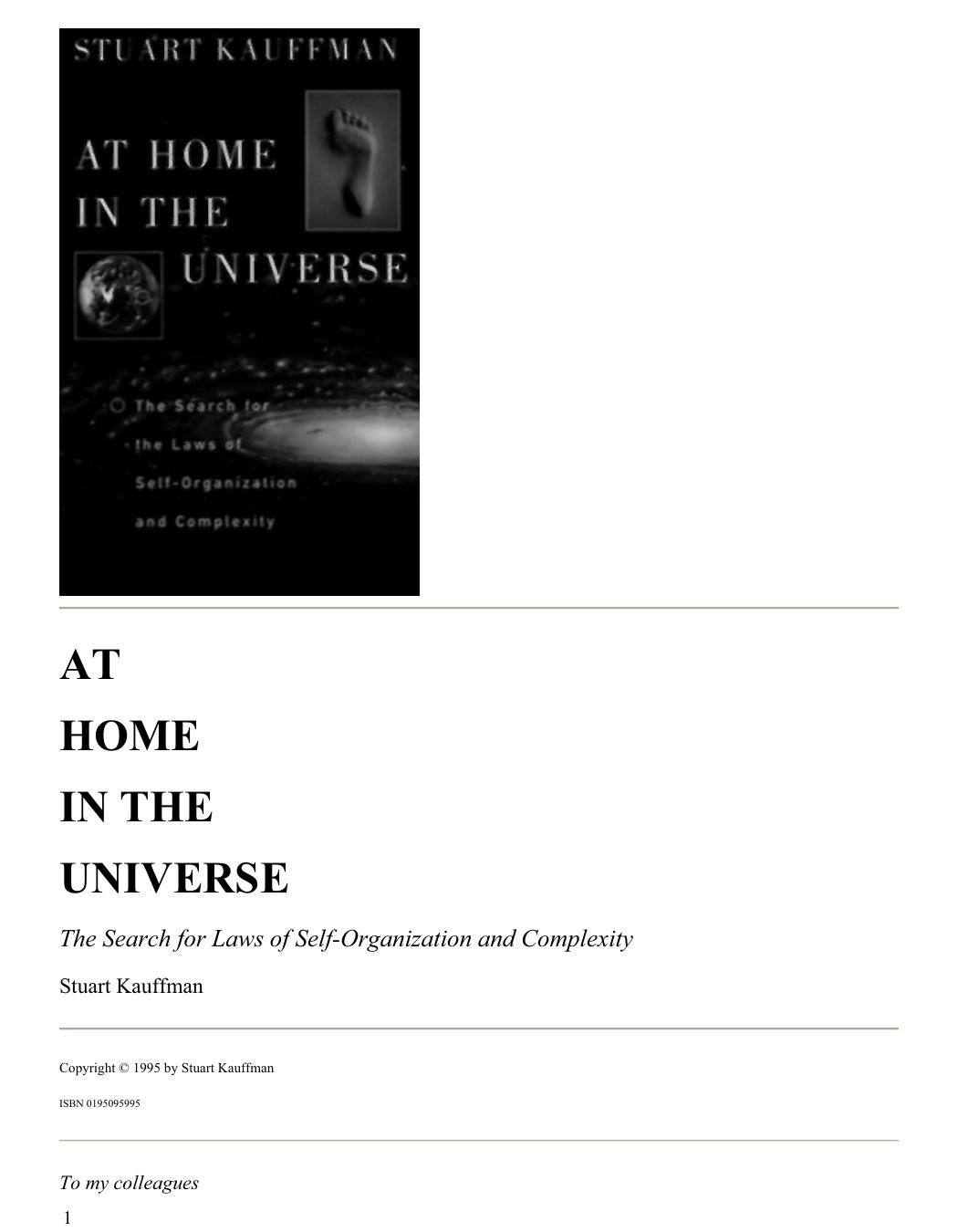At Home in the Universe: The Search for the Laws of Self-Organization and Complexity by Stuart Kauffman

Author:Stuart Kauffman [Kauffman, Stuart]
Language: eng
Format: epub, mobi, pdf
Published: 2008-10-06T07:30:00+00:00
Chapter 8
High-Country
Adventures
"edges in the economy of nature," wrote Darwin in his diary, leaving us with a glimpse of his own first glimpse of natural selection. Each organism, the fitter and the less fit, would wedge itself into the filled nooks and crannies of the tangled bank of life, struggling against all others to jam itself onto the wedge-filled surface of possibilities. Nature, red in tooth and claw, was the nineteenth-century image of natural selection. And natural selection would ever sift out the fitter from the less fit, ceaselessly screening, such that, down the eons, adapted forms would accumulate useful variations and proliferate. Later biologists, by the fourth decade of the twentieth century, would invent the image of an adaptive landscape whose peaks represent the highly fit forms, and see evolution as the struggle of populations of organisms driven by mutation, recombination, and selection, to climb toward those high peaks.
Life is a high-country adventure.
Make no mistake: the central image in biological sciences, since Darwin, is that of natural selection sifting for useful variations among mutations that are random with respect to their prospective effects on the organism. This image fully dominates our current view of life. Chief among the consequences is our conviction that selection is the sole source of order in biology. Without selection, we reason, there could be no order, only chaos. We the unexpected; we the very lucky.
Yet in this book we have seen profound sources of spontaneous order. Is it so clear that without selection there could be no order? I cannot think so. I believe we are entering a new era in which life will be seen as a natural expression of tendencies toward order in a far from equilibrium universe. I believe phenomena ranging from the origin of life to the order of ontogeny to the poised order of ecosystems we will discuss in Chapter 10 are all parts of order for free. Yet I, too, am a Darwinian, persuaded of the efficacy of natural selection. We stand in the deepest need of a new conceptual framework that will allow us to understand an evolutionary process in which self-organization, selection, and historical accident find their natural places with one another. We have no such framework as yet. The aim of this chapter is to show how selection works in its high-country adventure, but also to show its limitations, and then to attempt to sketch part of a new marriage of selforganization, selection, and accident.
It is one thing for me to tell those of you who are not biologists that self-organization plays a role in this history of life. Why not, you might say. And I agree that it seems obvious. After all, lipids in water do form hollow bilipid membrane spheres, such as cell membranes, without the benefit of natural selection. Selection need not accomplish everything. But nonbiologists typically do not understand the profound power the selection-is-the-only-source-of-order view holds for post-Darwinian biologists. Prior to Darwin, the Rational Morphologists, confronting what they believed were fixed species, could seek laws of form in the morphologies they collected.
Download
At Home in the Universe: The Search for the Laws of Self-Organization and Complexity by Stuart Kauffman.mobi
At Home in the Universe: The Search for the Laws of Self-Organization and Complexity by Stuart Kauffman.pdf
This site does not store any files on its server. We only index and link to content provided by other sites. Please contact the content providers to delete copyright contents if any and email us, we'll remove relevant links or contents immediately.
The Complete Stick Figure Physics Tutorials by Allen Sarah(7130)
Secrets of Antigravity Propulsion: Tesla, UFOs, and Classified Aerospace Technology by Ph.D. Paul A. Laviolette(4966)
Thing Explainer by Randall Munroe(3779)
The River of Consciousness by Oliver Sacks(3405)
The Order of Time by Carlo Rovelli(3068)
How To by Randall Munroe(2910)
I Live in the Future & Here's How It Works by Nick Bilton(2837)
A Brief History of Time by Stephen Hawking(2815)
What If?: Serious Scientific Answers to Absurd Hypothetical Questions by Randall Munroe(2541)
The Great Unknown by Marcus du Sautoy(2530)
Midnight in Chernobyl by Adam Higginbotham(2377)
Blockchain: Ultimate Step By Step Guide To Understanding Blockchain Technology, Bitcoin Creation, and the future of Money (Novice to Expert) by Keizer Söze(2375)
Networks: An Introduction by Newman Mark(2260)
The Meaning of it All by Richard Feynman(2210)
Easy Electronics by Charles Platt(2203)
The Tao of Physics by Fritjof Capra(2160)
Midnight in Chernobyl: The Untold Story of the World's Greatest Nuclear Disaster by Adam Higginbotham(2068)
When by Daniel H Pink(2018)
Introducing Relativity by Bruce Bassett(2014)
